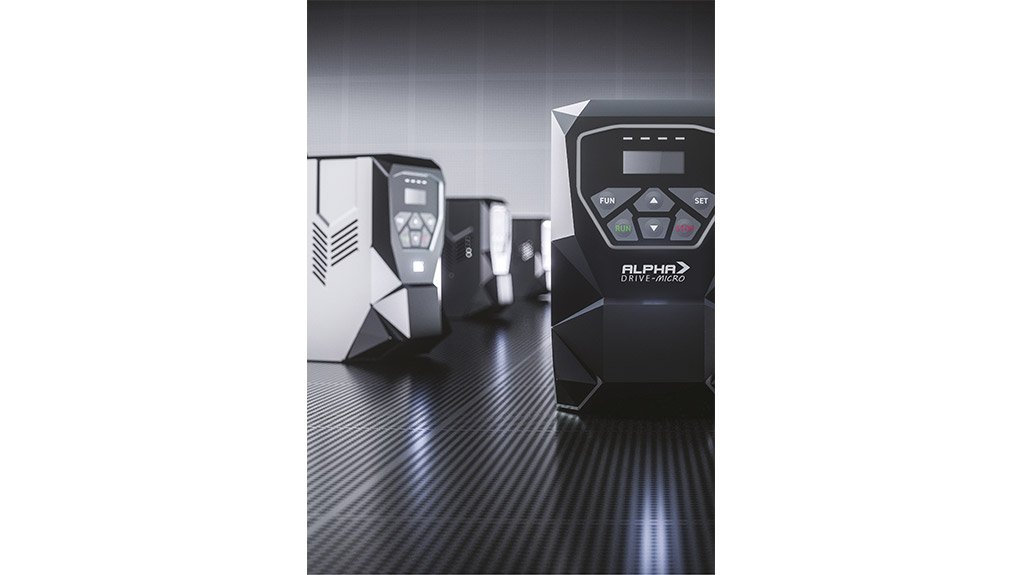
+27 11 899 0000
Lancaster Commercial Park, 12 Merlin Rose Drive (cnr. Lancaster Ivy), Parkhaven Ext.5, Boksburg, 1459
Disruptive tech can take industry forward



SHAUN COMBRINCK Improved efficiency and safety are part and parcel of embracing disruptive technology
DRIVING MODERNISATION The Varispeed Alpha Drive - Micro VSD is a compact frequency inverter ranging from 0.2 kW to 5.5 kW and is available in 240 V and 400 V
Mining industry decision-makers need to be more disruptive in their thinking to successfully bring optimisation and investment to the increasingly digitalised African mining sector, says transmission products distributor Bearings International (BI) business development leader Shaun Combrinck.
“Our challenge is that decision-makers are too often caught in traditional, nondisruptive thinking or are too absorbed by immediate concerns to think strategically about the forces of disruption and innovation shaping our future.”
He tells Mining Weekly that, amid the ongoing volatility of many commodities markets, mining companies need to ensure that their operations perform as efficiently as possible.
“This means managing assets in a safe and secure way, maximising production and increasing profitability.”
Combrinck states that harnessing new technology is central to safer and more efficient mining. This could include aspects such as proprietary technologies that help companies to locate deposits, and autonomous equipment and fatigue monitoring systems that protect personnel, as well as the leveraging of social media technology to foster better relations with stakeholders.
“The key is to select the right technology and make the best use of available data,” he says.
From BI’s perspective, one of the benefits of optimisation and investment in the increasingly digitalised mining environment of Africa is that digital transformation could unlock the full potential of a company’s assets and empower it to adopt predictive maintenance strategies.
“With the ability to look ahead, a mining company can prevent costly failures, reduce downtime and focus on shaping what’s next,” Combrinck states.
He emphasises that the health- and safety- related benefits of digitalisation are immense. The investment in and implementation of advanced automated digital solutions can help to distance workers from the dangerous conditions associated with the traditional labour-intensive mineral extraction process, subsequently creating a safer environment through remote monitoring.
Combrinck also notes the impact that the shift towards digitalisation and automation will have on jobs, adding that “digitalised processing will likely change the number of personnel required, as well as the nature of their skill sets”.
However, in terms of a ‘just’ transition from traditional jobs to modernised ones, he emphasises the importance of workforce mobility and flexibility, with upskilling or reskilling completed as needed.
Wits Mining Institute director Professor Fred Cawood, speaking at the SA GeoTech 2019 conference, in Kempton Park, in August last year, agreed that the solution was in diversifying the skill sets of professionals to ensure that they remained relevant.
He stressed that mining companies needed to ensure that personnel were consistently reskilled and/or upskilled to address skills gaps that arose from the introduction of new technologies.
“Workforce mobility and flexibility will ensure better alignment between the timing of . . . [skills required] and the remuneration structure of those employees,” Combrinck says.
On Show
As the industry spotlight remains firmly on optimisation and investment, BI – owned by holding company Hudaco Industries – will exhibit its modernised bearings and transmission solutions as part of Hudaco’s exhibition at the Investing in African Mining Indaba, in Cape Town this year.
“As one of the largest mining events in Africa, the Mining Indaba is very important for BI and Hudaco,” he says.
BI will showcase its range of international brands, comprising bearings and seals, chains and sprockets, pulleys and belts, electric motors and drives, as well as couplings and gearboxes.
“We have also added an extensive range of hydraulics and pneumatics to our offering. Further, BI now also offers conveyor belt idlers and pulleys in three series, as well as variable-speed drives (VSDs) from 0.37 kW to 400 kW,” Combrinck says.
The Alpha Drive-Micro VSD, from electronic motor control manufacturer Varispeed, also part of Hudaco, is a compact frequency inverter ranging from 0.2 kW to 5.5 kW and is available in 240 V and 400 V.
“Together with the VDrivePlus, these VSDs offer the best performance-to-cost ratio on the market, without compromising on quality and reliability. Given the current economic environment, the market is very price sensitive and, therefore, any energy efficiencies or cost savings we’re able to realise are beneficial to our customers,” Combrinck says.
He explains that the Alpha Drive-Micro and Micro Plus are certified in accordance with the latest European standards, and are ideally suited to most local applications, including mining, food and beverage, manufacturing and agriculture.
The larger VDrivePlus, from Varispeed, ranges from 0.4 kW to 400 kW, and is available in 240 V and 400 V. This more advanced VSD features advanced motor control, based on digital signal processing technology, together with smart auto-tuning.
Additional features of the drive include flexible inverter control, dual high-resolution analogue inputs, and free mappable input/output channels.
Further, Varispeed VSDs can be supplemented with BI’s range of Bauer electric motors.
“With our range of cast iron and aluminium motors, we can assist customers with a range of applications, from 0.18 kW to 355 kW, and between 400 V and 525 V or 550 V, including pumps, conveyor belts, sanding machines, cooling towers, crushers and pedestal drilling machines.
“A significant advantage to end-users, and one of the best-selling features of the cast iron motor range, is that its feet are removable and interchangeable, making it a multimount motor,” Combrinck concludes.



